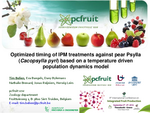Optimized timing of IPM treatments against pear Psylla (Cacopsylla pyri) based on a temperature driven population dynamics model
Pear suckers (Cacopsylla sp. or pear Psylla) (Hemiptera Psyllidae) are widely considered to be the most important pest in pear orchards. They are mostly feared by growers because of their secreted abundant honeydew colonized by sooty mould fungi causing blackening of leaves, shoots and fruits. Sustainable control of pear Psylla relies on their natural suppression by beneficial arthropods and a well-tuned integration of crop protection treatments. However, population dynamics of pear Psylla are complex with their presence in pear trees throughout the whole year in 4-5 consecutive generations in commercial pear growing in Northwestern Europe. On the other hand, main beneficial arthropods like predatory bugs (Anthocoris sp.) and earwigs (Forficula auricularia L.) are only at certain periods present as active psyllid predators on pear shoots and foliage. In order to achieve a maximal control efficacy on the pear Psylla population and a minimal side-effect on their natural enemies, we followed a modelling approach to optimize IPM treatment schedules and minimize required chemical sprayings (and residues). A temperature driven model forecasting the dynamics and populations structure (eggs/larvae/adults) of Pear Psylla was used to optimize timing of control sprayings targeting a specific life stage of the pest. In addition, impact on beneficial populations was minimized by avoiding non-selective treatments on their vulnerable life stages using a similar population dynamics forecasting modeling approach. This model-based strategy for an improved sustainable control of pear Psylla was tested in multiple field trials. The outcomes of these field validation trials are presented and discussed, providing valuable insights in model driven integrated pest management in commercial fruit growing.Key words: pear Psylla, model, beneficial arthropods, Integrated Pest Management, population dynamics
Documents

|
Optimized timing of IPM treatments against pear Psylla (Cacopsylla pyri) based on a temperature driven population dynamics model () Presentation title slide |
Details
- Activity type
- Participation in scientific conference
- Activity work package
- Reduction in pesticide residues
- Activity number
- PcFruit-WP3-a10
- Activity contact
- Tim Belien
- Activity partner
- pcfruit vzw
- Activity country
- Belgium
- Last edit
- 03-10-2017
Event
- Event name
- IOBC
- Event location
- Thessaloníki, Greece
- Event participants
- Tim Belien, researcher Zoology
Rik Clymans, researcher Zoology - Event dissemination
- oral presentation

The EUFRUIT thematic network has received funding from the
European Union's Horizon 2020 research and innovation programme
under grant agreement No 696337.
European Union's Horizon 2020 research and innovation programme
under grant agreement No 696337.